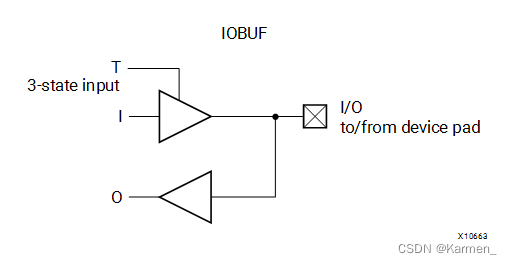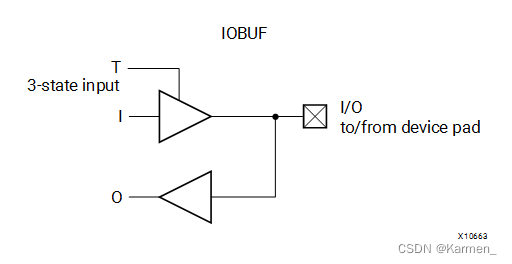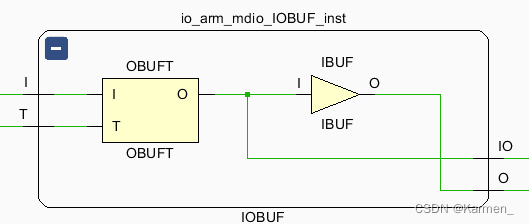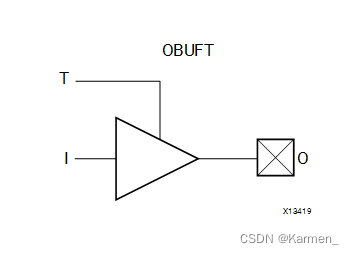Xilinx IOBUF 的用法
一、概念

1. 基本概念
应用场景: 在vivado中,连接的管脚的信号一般都会自动添加OBUF或IBUF。但是对于inout类型的接口,不会主动添加IOBUF,因为in/out切换需要控制信号,需要用户自己分配好。
Xilinx官网原文: The IOBUF primitive is needed when bidirectional signals require both an input buffer and a 3-state output buffer with an active-High 3-state T pin. The IOBUF is a generic IOBUF. A logic-High on the T pin disables the output buffer. When the output buffer is 3-stated (T = High), the input buffer and any on-die receiver termination (uncalibrated or DCI) are ON. When the output buffer is not 3-stated (T = Low), any on-die receiver termination (uncalibrated or DCI) is disabled.
I/O attributes that do not impact the logic function of the component such as IOSTANDARD, DRIVE and SLEW should be supplied to the top-level port via an appropriate property. For details on applying such properties to the associated port, see the Vivado Design Suite Properties Reference Guide (UG912).
个人翻译: 当双向信号需要输入缓冲区和带active-High 3态T引脚的3态输出缓冲区时,需要IOBUF原语。IOBUF是一个通用的IOBUF。T为高电平时关闭output buffer(I端口)。当output buffer为3-state (T = High)时,input buffer和任何固定接收器终端(未校准或DCI)均为有效。当输出缓冲区不是3-state (T = Low)时,任何固定接收器终端(未校准或DCI)都是禁用的。
不影响组件逻辑功能的I/O属性(如IOSTANDARD、DRIVE和kill)应该通过适当的属性提供给顶级端口。有关将这些属性应用到相关端口的详细信息,请参见Vivado设计套件属性参考指南(UG912)。
Vivado原语:
// IOBUF: Single-ended Bi-directional Buffer
// All devices
// Xilinx HDL Language Template, version 2017.2
IOBUF #(
.DRIVE(12), // Specify the output drive strength
.IBUF_LOW_PWR("TRUE"), // Low Power - "TRUE", High Performance = "FALSE"
.IOSTANDARD("DEFAULT"), // Specify the I/O standard
.SLEW("SLOW") // Specify the output slew rate
) IOBUF_inst (
.O(O), // 1-bit output: Buffer output
.I(I), // 1-bit input: Buffer input
.IO(IO), // 1-bit inout: Buffer inout (connect directly to top-level port)
.T(T) // 1-bit input: 3-state enable input
);
个人理解: 这玩意儿的解释有点绕,我们结合结构图、原文、原语来总结一下,大致是这么个意思:
首先,我为什么说它绕,因为IOBUF的O指的是IO_pin >> FPGA,也就是说这里的Output输出的主语是IO_pin,而不是FPGA;这里的 I 指的是IO_Pin << FPGA,同样主语是IO_pin,这里指的是输入到IO_pin。所以第一次使用的时候容易弄混。
再与结构图结合就很容易理解了,三态门T控制的是I端口能否有效输入:
- T拉高时,I端口停止工作,O端口向FPGA内部输出信号;
- T拉低时,I端口向IO_pin输入来自FPGA内部的信号,此时 O = I(因为O端口从这个方向上来说也是 I 的分支);
2. 硬件结构
2.1 IOBUF
官网原图:

Vivado综合后的RTL视图:

真值表:
|
|
|
| |
|---|---|---|---|
|
|
|
|
|
|
|
|
|
|
|
|
|
|
|
|
|
|
|
|
接口描述:
| Port | Direction | Width | Function | 带有个人情感色彩的翻译 |
|---|---|---|---|---|
| I | Input | 1 | Input of OBUF. Connect to the logic driving the output port. | OBUF的输入端,连接到Output端口的逻辑驱动 |
| IO | Inout | 1 | Bidirectional port to be connected directly to top-level inout port. | 双向端口被直接连接到顶层的inout端口 |
| O | Output | 1 | Output path of the buffer. | IOBUF的输出路径 |
| T | Input | 1 | 3-state enable input signifying whether the buffer acts as an input or output. | 3态门启用输入,表示IOBUF是作为输入还是作为输出。 |
2.2 OBUFT

真值表:
|
|
| |
|---|---|---|
|
|
|
|
|
|
|
|
|
|
|
|
|
|
|
|
接口描述:
| Port | Direction | Width | Function | 带有个人偏见的翻译 |
|---|---|---|---|---|
| I | Input | 1 | Input of OBUF. Connect to the logic driving the output port. | OBUF的输入端,连接到Output端口的逻辑驱动 |
| O | Output | 1 | Output of OBUF to be connected directly to top-level output port. | OBUF的输出端被直接连接到顶层的output端口 |
| T | Input | 1 | 3-state enable input. | 三态门使能输入 |
二、实例
首先我们想象这样一个应用场景:
因为某些原因,ARM不能直接连接到PHY芯片上,所以需要通过FPGA间接与PHY芯片相连接,这个时候我们就有以下引脚:
input i_arm_mdc,
inout io_arm_mdio,
output o_phy_mdc,
inout io_phy_mdio
而根据MDIO协议:


IO端口切换输入输出模式的根据是OP位,所以我们可以先设置一系列寄存器来存储io_arm_mdio的input内容,以及读写变化使能。
reg s_mdio_rd_en;
reg [35:00] s_mdio_word ;
reg [01:00] s_mdio_op ;
reg [05:00] s_cnt_mdio ;
reg s_add_mdio ;
wire s_arm_out ;
wire s_phy_out ;
assign o_phy_mdc = i_arm_mdc ;
always @(posedge i_arm_mdc or negedge i_rst_n)begin
if(!i_rst_n) begin
s_mdio_word <= 36'b0;
end
else begin
s_mdio_word <= {s_mdio_word[34:00],s_arm_out};
end
end
/* ---- mdio contrl ---- */
always @(posedge i_arm_mdc or negedge i_rst_n) begin
if (!i_rst_n) begin
s_add_mdio <= 1'b0;
s_mdio_op <= 1'b0;
end
else begin
if((s_mdio_word==36'hffffffff6||s_mdio_word==36'hffffffff5) && s_mdio_trans_cnt == 8'd35)
s_add_mdio <= 1'b1;
else if(s_cnt_mdio >= 16'd27)
s_add_mdio <= 1'b0;
else
s_add_mdio <= s_add_mdio;
if (s_add_mdio)
s_cnt_mdio <= s_cnt_mdio + 1'b1;
else
s_cnt_mdio <= 1'b0;
if(s_mdio_word==36'hffffffff6 && s_mdio_trans_cnt == 8'd35)
s_mdio_op <= Read_bits;
else if (s_mdio_word==36'hffffffff5 && s_mdio_trans_cnt == 8'd35)
s_mdio_op <= Write_bits;
else
s_mdio_op <= s_mdio_op;
end
end
always @(posedge i_arm_mdc or negedge i_rst_n)begin
if(!i_rst_n)begin
s_mdio_rd_en <= 1'b0;
end
else begin
if(s_cnt_mdio>=6'd9 && s_mdio_op == Read_bits)/* 5-bit PHY_ADDR + 5-bit Reg_ADDR = 10-bit */
s_mdio_rd_en <= 1'b1;
else
s_mdio_rd_en <= 1'b0;
end
end
在需要的参数都准备好后,就可以开始使用原语了:
IOBUF #(
.DRIVE(12), // Specify the output drive strength
.IBUF_LOW_PWR("TRUE"), // Low Power - "TRUE", High Performance = "FALSE"
.IOSTANDARD("DEFAULT"), // Specify the I/O standard
.SLEW("SLOW") // Specify the output slew rate
) IOBUF_inst_arm (
.O (s_arm_out ), //
.IO(io_arm_mdio ), //
.I (s_phy_out ), //
.T (!s_mdio_rd_en ) // 3-state enable input, high=input, low=output
);
IOBUF #(
.DRIVE(12), // Specify the output drive strength
.IBUF_LOW_PWR("TRUE"), // Low Power - "TRUE", High Performance = "FALSE"
.IOSTANDARD("DEFAULT"), // Specify the I/O standard
.SLEW("SLOW") // Specify the output slew rate
) IOBUF_inst_phy (
.O (s_phy_out ), //
.IO(io_phy_mdio ), //
.I (s_arm_out ), //
.T (s_mdio_rd_en ) // 3-state enable input, high=input, low=output
);
最后综合出来的结果就是这个样子:























 3622
3622











 被折叠的 条评论
为什么被折叠?
被折叠的 条评论
为什么被折叠?








